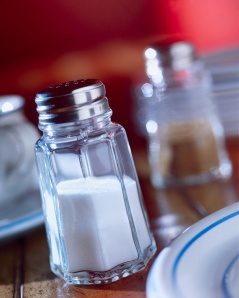
Dining out used to be such a big deal. When I was a little girl growing up in St. Catharines, a rare family outing to our neighbourhood Chinese noodle house was as exciting as life could possibly get.
Today, Canadians spend over 30% of our food budget at restaurants (compared to 42% for our American friends!) The average household goes out for a meal, snack or beverage an average of 11 times every two weeks. Of all the money spent on food in Canada, 40% is spent in some of our 62,000+ food service outlets. But with the growing popularity of drive-thru, take-out and delivery services, 60% of restaurant-prepared items are now consumed elsewhere. And on any given day, 30% of kids living in North America visit a fast food restaurant.
That’s a whole lot of fast food, and a whole lot of salt.
Health Canada tells us that a diet high in sodium chloride (salt) is associated with high blood pressure, a major risk factor for stroke, heart disease and kidney disease.The recommended maximum intake of sodium for a healthy adult is 1,500 mg daily.
For those with high blood pressure, or for heart attack survivors like me, it’s less than 1,000 mg. Most of the sodium we consume every day comes from processed foods – not from the salt shaker. The Portuguese Parliament has just passed a groundbreaking new law that actually limits the amount of sodium that manufacturers in Portugal can now put into all processed foods.
Here are some staggering sodium content numbers to keep in mind when eating out:
- 1 taco salad = 1,800 mg of sodium
- 1 taco or bean burrito = 1,200 mg
- 8 nachos with cheese sauce = 816 mg
- 1 tablespoon of salsa = 96 mg
- 1 serving of spaghetti with meat sauce = 1,600 mg
- 1 slice of pepperoni pizza = 670 mg
- 1 cup of miso soup = 2,500 mg – YES! That’s way more than your daily max!
- 1 5.5-ounce serving of Mandarin chicken = 1,150 mg
- 1 tablespoon of soy sauce = 902 mg
- 1 tablespoon of teriyaki sauce = 690 mg
- 1 5.5-ounce serving of mixed vegetables = 370 mg
- 1 grilled chicken club sandwich = 1,690 mg
- 1 6-inch submarine with cold cuts = 1,651 mg
- 6–8 breaded and fried shrimp = 1,446 mg
- 1 fish sandwich with tartar sauce = 1,270 mg
- 1 cheeseburger = 1,108 mg
- 1 piece of battered fish = 790 mg
- 1.5 ounces of low-fat balsamic vinaigrette = 730 mg
- plain Caesar salad = 180 mg
- plain Caesar salad with 2 ounces of dressing = 680 mg
- small order of French fries = 160 mg
- 1 packet of ketchup = 100 mg
- fruit and yogurt parfait = 85 mg
Speaking of restaurants, did you know that Denny’s in the U.S. is being sued because of its salty menu? Learn more from the Cleveland Clinic about how to shake that salt habit.
Are you curious if sea salt is better for us than table salt? According to Mayo Clinic experts:
“Sea salt and table salt have the same basic nutritional value, despite the fact that sea salt is often marketed as a more natural and healthy alternative. The real differences between sea salt and table salt are in their taste, texture and processing, not in their chemical makeup.”
And instead of putting all that salt into your body, consider these miracle uses for salt from the Salt Institute – everything from making dripless candles to invigorating your tired goldfish.
Question: Recently, one of my readers asked this about salt:
“Campbell soup ads are promoting ‘lower sodium sea salt’ for their higher-end soups. I have researched the internet and found a large number of articles that show there is no difference in the sodium content between sea salt and regular table salt. How does Campbell, and many other companies, justify the claim of less sodium in sea salt?”
© 2009 Carolyn Thomas www.myheartsisters.org

I found an answer to your readers question about sea salt vs regular table salt from the Mayo Clinic:
“Sea salt and table salt have the same basic nutritional value — both mostly consist of two minerals — sodium and chloride. However, sea salt is often marketed as a more natural and healthy alternative. The real differences between sea salt and table salt are in their taste, texture and processing, NOT their chemical makeup.
By weight, sea salt and table salt contain about the same amount of sodium chloride. ”
Thanks for bringing this up.
LikeLike
“…Most of the sodium we consume every day comes from processed foods – not from the salt shaker…”
This to me is shocking. Gratefulness you on your salt information.
LikeLike
I have put a link to this article from my pharmacy website. Thank you.
LikeLike
I have put a link from my pharmacy website to this article. Thank you.
LikeLike
Hello, can you please post some more information on this topic of salt? I would like to read more.
LikeLike